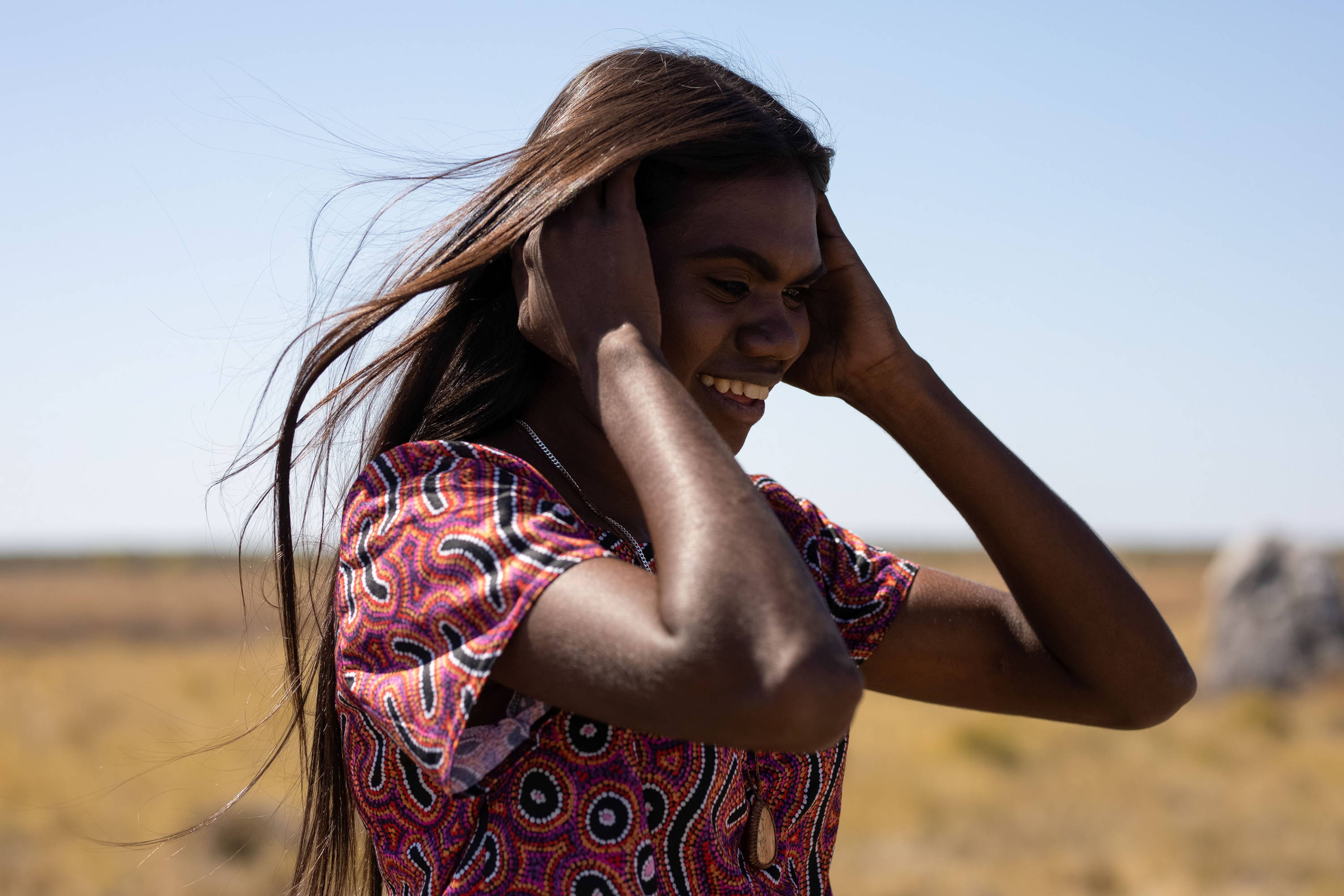Hayley Mulardy on NAIDOC Week, Modelling and Keeping Culture Alive
If you’ve spent any amount of time on Yarn’s website then you’ve almost certainly seen an image of Hayley Mulardy. One of our most popular models, Hayley’s striking presence in front of the camera comes from her confidence and pride in who she is and where she is from.

A proud Karajarri woman, Hayley was raised in a community called Bidyadanga (La Grange Mission), located 180km South of Broome. It is the largest remote Aboriginal community in Western Australia, home to some 850 people, and its name means “emu watering hole” (pijarta or bidyada). While the recognised traditional owners of the land are the Karajarri people, Bidyadanga is also home to the Juwalinny, Mangala, Nyungamarta and Yulpartja language groups. It is a diverse and thriving community that Hayley is proud to be a part of.
She recalls her childhood spent learning both at school and traditionally through spending time with her family. She also recalls turning down regular offers for modelling. “All my life people have been asking me to model because of the way I look,” she says. “But I was more into studying at school, playing basketball or football, or even going out fishing and hunting with my family.”
She was eventually persuaded by her school’s art teacher Sheree Ford (who is involved with Ngula Jarndu in Broome) to model some designs. From there, she says, “it just got bigger. More people wanted me for photoshoots and I kind of got used to it.”
“I am proud to be a young Karajarri woman… I would do anything to keep my culture strong.”
Got used to it indeed. Hayley models regularly for community and fashion events around WA and for brands who work with First Nations art and clothing. She considers it an honour and hopes that her work inspires other Indigenous women to pursue their dreams.
Through everything she does, she shares her strength and pride. “I love everything about my culture,” she declares. “I am proud to be a young Karajarri woman. Yes, we may be different tribes but we are one big family. We love and appreciate everyone in this community. To be helping such a strong group of Elders, young adults and kids is an honour. I would do anything to keep my culture strong.”

Hayley credits her family’s support for her strength, particularly her Grandparents. “It felt like every day was special,” she tells us.
“My Grandfather would take us kids out looking for bush turkeys, kangaroos and even chasing goannas. It didn't matter what gender, he taught everybody how to hunt.” She treasures the memories from this time, saying, “my Grandmother would always tell stories and sing to us at night around a campfire. She taught every single one of us how to speak her language (Karajarri) and how we should teach our new generations. To me, They were Legends.”
“They're here to not let our cultures disappear, to teach the new generations and many generations to come.” [On Elders]
Hayley is quick to acknowledge she is lucky to have the memories she does. When asked what this year’s NAIDOC Week theme “For Our Elders” means for her, she replies clearly: it means a lot. “They are our traditional Elders who have come from far and wide,” she explains. “They sacrificed so much for our generation, just for us to live and learn like everybody else. They're here to not let our cultures disappear, to teach the new generations and many generations to come.”

And Hayley herself is playing a role in preserving her culture. She currently works as an Aboriginal Ranger for the Karajarri area in joint claim with nyangumarta, where her team applies cultural expertise from thousands of years of history and knowledge to manage land, improve environment health and biodiversity and avert natural disasters.
Come NAIDOC Week, she plans to celebrate in Bidyadanga by “getting together as different tribes, and having a big feed. The boys go out hunting while the girls cook up a feed.” Most importantly, she says, “the Elders make us a delicious Damper that can be served with anything. We mostly like taking our Elders out to Country so they can tell us stories and even sing us cultural songs.”

When asked if there is anything special she’d like to add, she takes the time to thank her old art teacher, Sheree, her family, and her mother for pushing her to model. In fact Hayley’s mother Tracey is quite the model herself, stepping in front of the camera for our NAIDOC polo photoshoot (above). Hayley’s talent hasn’t fallen far from the tree, it seems.
Finally, she says, “thank you to Yarn and its amazing photographer, otherwise I wouldn't be looking so good.” While there’s no way we can take credit for that, we will certainly be supporting Hayley on her journey to inspiring others through her culture and craft.
You can follow Hayley on Instagram through her handle @mulardy17

Love Our Blogs? Read More Articles Now!
Yarn Blog is here to bring you the latest and greatest in First Nations culture, news and shopping. You can find updates on all our best products as well as info about our fantastic collaborating artists right here. Click below to start reading more of our exciting posts!







